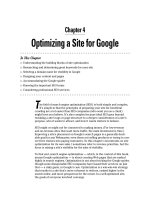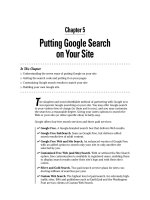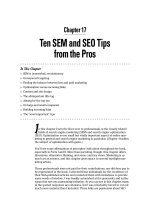Ten Site Optimization Resources
Bạn đang xem bản rút gọn của tài liệu. Xem và tải ngay bản đầy đủ của tài liệu tại đây (1.08 MB, 18 trang )
Chapter 16
Ten Site Optimization Resources
In This Chapter
ᮣ
Search Innovation
ᮣ
HighRankings.com
ᮣ
Mediumblue.com
ᮣ
Keyword verification and link popularity tools
ᮣ
TopSiteListings.com
ᮣ
SEO Consultants directory
ᮣ
Search Engine World tools
ᮣ
JimWorld
ᮣ
Eric Ward
ᮣ
SEO directory
O
ptimizing your Web site is not a Google-exclusive tactic. A site optimized
according to globally recognized standards attains better stature than a
non-optimized site in every search engine. The SEO (search engine optimiza-
tion) field predates Google’s index and PageRank algorithm. Living as we do
in the Google era, however, SEO is mainly concerned with Google-specific
page optimizing. In this regard, most professional optimizers are one of two
types: general optimizers who work across the board or Google optimizers.
The truth is, optimizing exclusively for Google is needlessly fanatical. First,
Google doesn’t publicize its algorithm tweaks and the subsequent recalcula-
tions of PageRanks and reordering of search results. Following a silent but influ-
ential Google upgrade, wails of anguish from Webmasters around the world can
be heard as their sites drop from previously hard-won positions. As a commu-
nity, Google optimizers try to figure out what changed and how to reoptimize
their domains. This manic-depressive process is ongoing and necessary, but
it probably shouldn’t be the only page-tweaking task on your plate.
Second, and the main reason that general optimization is the way to go,
all important search engines respond well to the same basic optimization
improvements. If your site needs an optimization overhaul, chances are the
most basic spider-friendly improvements will dramatically raise your visibil-
ity in Google — and in any other index that lists your site.
24_571435 ch16.qxd 5/21/04 11:42 PM Page 283
284
Part V: The Part of Tens
Hitch your wagon carefully
This chapter spotlights optimization sites, tools,
gadgets, and more. When following these sug-
gestions and exploring on your own, you’re bound
to encounter some strong come-ons from opti-
mization companies and specialists. SEO is a
competitive field, especially with the Google feed-
ing frenzy. Some optimization pitches resemble
get-rich-quick spam. Outlandish promises are fol-
lowed by unrealistic (and probably untrustwor-
thy) guarantees. However, I’m not one to throw
out the baby with the bathwater. (Who coined
that barbaric expression?) Plenty of great opti-
mization specialists are just a link away. You just
need to know the telltale signs to avoid.
Guarantees of any sort should set off alarms in
your head. Google’s indexing can lead to unpre-
dictable results — and no optimizer can seriously
promise a specific search ranking or ad position.
The more dramatic the guarantee, the less
you should trust it. Guaranteed number-one
placement on a search results page is frankly
absurd. You might indeed claim the top spot for
certain keywords, but don’t believe anyone who
promises you such a thing. Another enticement
is the promise of placement on the first page of
listings — this is both unrealistic and a bit sleazy.
The first results page in Google can be as short
as 10 listings or as long as 100, depending on the
user’s Preferences setting.
Automated optimization is troublesome. Certain
handy tools automate the creation of
meta
tags;
I cover these tools in this chapter and they’re
fine. Automated measurements — of keyword
density and crawler readiness, for example —
might or might not be accurate or helpful, but
they’re not dangerous. But automated rank-
checking engines violate Google’s terms of ser-
vice and can get your site into hot water.
Optimization is mostly a hands-on affair. Some
SEO companies sell software packages that
assist the process with a combined set of online
and offline tools. Various invasive elements can
be planted in your computer whenever you install
a new program, and I’ve never found it necessary
or desirable to employ desktop applications when
optimizing.
Speaking of automation, some companies offer
bulk submissions to hundreds of search engines.
According to traffic measurement statistics, more
than 95 percent of all search engine traffic
derives from a handful of top engines. Hiring
somebody to bulk-submit your site globally might
not be the best investment.
Link farming (see Chapter 3) is not optimizing. Be
wary of any SEO company that proposes mutual
links between its site and yours.
Finally, understand the difference between opti-
mized results and paid results. Some search
engines (not Google) accept fees for placement
in their search results (not off to the side). Nothing
is inherently unethical in this business model,
even though it did give the entire search industry
a bad reputation in the 1990s. But a lack of ethics
is at play when an optimization consultant spends
your money gaining paid placement in some
search engines instead of spending it working
up the Google results page. Sometimes this
strategy is used to fulfill a promise of top-page
search listing — a promise that should never be
made to begin with.
24_571435 ch16.qxd 5/21/04 11:42 PM Page 284
Google optimization, as a specific tactic, comes into play when a Webmaster
limits the entire marketing plan to Google. There’s nothing wrong with that at
Google’s current levels of traffic. (See Chapter 1 for a discussion of Google’s
competition and the prospects for the future.) Another example of Google-
specific optimization is a highly optimized site that tweaks its page features
specifically to eke out better returns from Google. In both cases, optimiza-
tions made for Google tend to help in other search engines, just as general
optimization helps in Google.
The resources suggested in this chapter fall into three categories:
ߜ Do-it-yourself optimization. These sites offer tutorials, interactive tools,
directories, and other resources, some of which might cost money.
Don’t expect consulting, site management, or individualized optimiza-
tion reports.
ߜ Don’t-do-it-yourself optimization. These companies and individuals cater
to Webmasters and businesses that don’t want to master optimization fun-
damentals or plunge their hands into code and keywords. This category
also includes many of the questionable SEO practices that leverage their
clients’ naiveté and need to outsource, promising unrealistic results and
employing unwholesome strategies. At the same time, this space is where
you find the many honest, smart, and skilled optimization specialists who
can deliver personalized site evaluations for a reasonable cost, tighten
your code, deepen your keyword identity, and multiply your Google-
derived leads in a single crawl cycle. Don’t be afraid of SEO specialists;
just be cautious.
ߜ Hands-on tools. Online gadgets! Keyword analyzers,
meta
tag generators,
page evaluators, and other interactive assistants populate this category.
These tools are for the do-it-yourself crowd.
Some sites cover all three bases. SEO specialists usually (but not always)
include some do-it-yourself content on their sites.
Search Innovation
www.searchinnovation.com
Search Innovation is a search engine marketing company with a strong opti-
mization streak. Two sections of this site generously provide information: the
Articles and Resources sections.
285
Chapter 16: Ten Site Optimization Resources
24_571435 ch16.qxd 5/21/04 11:42 PM Page 285
The site’s articles, mostly written by founders Daria and Dale Goetsch, are
detailed, serious, and informative. These pieces cover such topics as effective
keywords, “organic” SEO (the practice of optimizing toward high placement
in search listings, as opposed to purchasing placement on search pages),
optimizing dynamic pages (a tricky subject many optimizers don’t go near),
link building, SEO myths, crawler methods, building site maps, writing effec-
tive link text, and content writing.
The articles at this site are enough to get this site mentioned in this chapter,
but the Resources page shines just as brightly. Here you find a directory of
forums, newsletters, blogs, interactive tools, seminars, and Web sites that are
resourceful in other ways.
HighRankings.com
www.highrankings.com
Operated by Jill Whelan, an optimization consultant, the HighRankings site
is distinguished by a friendly atmosphere, a generous allotment of free arti-
cles, a free, almost-weekly newsletter, and a discussion forum dedicated to
optimization.
The High Rankings Advisor newsletter, contains articles by Whalen and
guest writers. Many of these pieces are archived in the Advisor Articles
section; new and mid-level optimizers would do well to read through
the whole lot of them. The articles tend to be detail-oriented, with, for
example, entire tutorials devoted to a single
meta
tag. You can also find
great information about getting framed sites indexed in Google, submitting
to directories, and other basic tasks sometimes ignored by high-pressure
optimization shops. HighRankings.com maintains a vigorous do-it-yourself
sensibility, even as it offers site evaluations, writing services, and content
editing.
The discussion forum is possibly the most thorough and SEO-dedicated set of
message boards anywhere. This forum hosts well over 1000 topics and about
15,000 messages covering every possible aspect of site optimization. (See
Figure 16-1.)
Jill Whalen is an active participant and friendly moderator of the voluminous
Webmaster chatter. Conversations, like the articles, tend toward technical
details. Participants use the space to work out fine points of site coding, CSS
style sheets, supplementary programs that bundle code in spider-friendly
ways, strategies for organizing page elements at the code level, and so forth.
I recommend the HighRankings forum most highly to serious optimizers and
Webmasters at all levels who have questions.
286
Part V: The Part of Tens
24_571435 ch16.qxd 5/21/04 11:42 PM Page 286
Mediumblue.com
Newsletters and newsletter archives are a terrific resource for optimization
tips. Beyond the sheer informational value, receiving newsletters sparks
continued work on your site, reminding you that optimization is an ongoing
(frankly, never-ending) occupation. True, you can’t avoid repetition when
scanning dozens of articles, but sometimes we need to be nudged repeatedly
to do our online chores.
Medium Blue is an optimization and marketing consultancy with a free monthly
newsletter. Less chatty and varied than Jill Whalen’s High Rankings Advisor
(see the preceding section), the Medium Blue sheet is informative in its formal
way. Each newsletter is a single article utterly lacking in chatter, ads, links,
and other distractions.
Past editions are archived back to November 2001, forming a useful knowledge
bank covering subjects as diverse as keywords (of course), evaluating site per-
formance, monitoring search engine positions, long-term techniques to attain
high rankings, and site traffic analysis. Broad rather than detailed, the arti-
cles don’t divulge finicky matters of HTML tagging or keyword density. One
newsletter from 2003 contains an interview with the founder of Wordtracker
(see Chapter 4).
Figure 16-1:
The High-
Rankings.
com forum
is the most
impressive
discussion
area for
search
optimization
topics.
287
Chapter 16: Ten Site Optimization Resources
24_571435 ch16.qxd 5/21/04 11:42 PM Page 287
Keyword Verification and
Link Popularity Tools
This section spotlights a few interactive tools. These pages don’t provide opti-
mization tools per se, such as
meta
tag generators. Rather, these gadgets check
on the results of your optimization efforts in two areas:
ߜ Keyword verification, which checks a URL’s presence on the results
pages of several search engines, when searching for certain keywords
ߜ Link popularity, which checks the number of incoming links to a URL, as
viewed through multiple search engines
Marketleap Keyword Verification tool
www.marketleap.com/verify
Marketleap.com provides an integrated set of optimization checks. The two
tools described here are beautifully designed and create elegant displays of
results. These gadgets are free to use.
Figure 16-2 shows the Keyword Verification tool. It tells you whether your site
(or specific page) is returned in the search results of 11 major search engines
and, if so, on what search results page it appears. (The definition of a results
page is not provided; my experiments indicate that a page probably equals 10
results.)
Follow these steps:
1. Enter a URL.
If you’re checking an inner page of your site, you don’t need to enter the
full address of that page, although it doesn’t hurt to do so. Marketleap
finds inner-page matches to your keywords to whatever extent the tested
search engines can find them.
2. Enter a keyword or phrase.
Type whatever you’ve optimized for, as if a Google user were searching for
that phrase. You’re likely to get more encouraging results if you enter a
phrase, not a single word. Placing quotes around the phrase, for an exact
match to word order, creates more hits, but doesn’t necessarily create a
realistic report of your site’s visibility to the average Google user.
288
Part V: The Part of Tens
24_571435 ch16.qxd 5/21/04 11:42 PM Page 288
3. Enter the displayed access code.
Simply type the code that appears in colored letters. Forcing users to
replicate the code prevents this tool from being overused by automated
scripts.
4. Click the Generate Report button.
A moment after the results first appear, they’re redrawn in a table, as
shown in Figure 16-3.
Note in Figure 16-3 that some engines match your keywords with a targeted
inner page (in this example, the page that’s best optimized for the keyword
phrase), and other engines can’t see that deeply. Google has crawled the site
carefully, but AltaVista has not.
Marketleap doesn’t check any engines beyond the third page. If your page
doesn’t appear in the results table, the omission is not necessarily an indica-
tor that your page has not been crawled by that engine. However, it does indi-
cate that the page is not optimized powerfully for that engine. In the context
of this book, Google is the top priority, so all is well with the results shown in
Figure 16-3.
Figure 16-2:
The
Marketleap
Keyword
Verification
tool, ready
to search
the engines
for a site’s
visibility
against
keywords.
289
Chapter 16: Ten Site Optimization Resources
24_571435 ch16.qxd 5/21/04 11:42 PM Page 289









